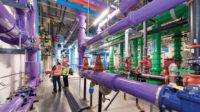As the Southeast’s robust construction market continues into another year, contractors continue to enjoy overall bottom-line growth even as activity shifts among various sectors. ENR Southeast’s Top Contractors survey netted 120 respondents that collectively reported $37.3 billion in 2017 revenue, up roughly 10.5% from the previous year’s total of $33.8 billion. State-by-state construction revenue mostly held steady last year, with the exception of Puerto Rico, with revenue decreasing notably there.
Several contractors note that multifamily residential projects—a key regional driver over the past several years—is showing signs of a slowdown as supply overtakes demand in many areas. Similar strains may be slowing the pace of projects in the hospitality sector.
But on the whole, contractors like what they’re seeing.
“Everyone seems to have a healthy backlog,” observes Dan Kaufman, regional president for JE Dunn Construction.
Those sentiments were shared by Pete Tuffo, president and general manager of Suffolk Construction’s Southeast region, who says the market’s performance is in line with expectations, with foreign investment playing a strong role. He adds that while the commercial market continues to perform well, “we’ll see that stabilize over the next few years, along with a minor uptick in institutional sectors.”
Transportation is showing similar strength. Mark Johnnie, Balfour Beatty’s Southeast region vice president, credits the uptick in projects to reliable federal spending under the 2015 FAST Act, coupled with several state-level funding initiatives.
“You could name any city of significance in the Carolinas, Georgia and Florida, and there are either major transportation projects underway or planned,” Johnnie says. He adds that the presence of ports in those states has spurred efforts to improve the flow of goods to and from those facilities.
Johnnie worries, however, that the region’s growing water and wastewater infrastructure needs are not being addressed. “The demand is there, but the funding is more challenging,” he says.
ENR Southeast Top Contractors 2018
Labor Shortage Looms Large
An issue affecting all sectors is the steadily growing shortage of skilled craft labor. Kaufman says Nashville is particularly stressed, given the city’s $1-billion airport upgrade and multiple tourist-oriented downtown development projects. “It’s our deepest hole for talent,” he says.
Locking in quality subcontractors for projects is also becoming more difficult. Huntly Gordon, president of New South Construction, reports that specialty firms are becoming “more selective about the jobs they want to be a part of,” with project scope and location often determining whether they want to negotiate for a job.
Adding to contractors’ concerns are the Trump administration’s recent threats to impose new tariffs on imported steel and other materials, which most believe could cause costs to escalate. Rob Taylor, president of Brasfield & Gorrie, says that could exacerbate pressures resulting from the recent consolidation of the Southeast’s two largest rebar suppliers. “That leaves fewer options, so you know higher prices will follow,” he says.
Contractors are also seeing a more subtle, though no less important shift in the way clients want projects carried out, with a trend toward earlier collaboration among participants and stakeholders to resolve design and constructibility issues.
Kaufman says clients in technology and other advanced industries are relying more on design-build and incentive-based, shared-risk projects in order to ensure delivery schedules are met. “They want to be assured that the project won’t slide,” he explains.
Offsite construction methods such as prefabrication, modularization and preassembly could provide a means for contractors to address at least some of these challenges.
“We’re definitely looking for opportunities to do it,” Taylor says, adding that along with helping bridge skilled labor gaps, “it also improves safety, efficiency and project logistics.”
Most contractors expect market conditions to remain steady for the remainder of the year and into 2019. Aside from unforeseen economic events, the variable carrying the most disruptive potential is weather. And it’s not just the region’s vulnerability to hurricanes that’s at issue. Unseasonably cold, damp winter weather in many parts of the Southeast played havoc with several projects, according to Taylor.
“Several times we had to bring in temporary heat for drying-in work,” he says. “Once that was done, we had to scramble to get things back on schedule.”
Johnnie notes that depending upon the severity of the weather events, the region’s clients are, for the most part, willing to work with contractors to mitigate schedule impacts.
About the Survey
ENR Southeast’s Top Contractors survey ranks firms based upon revenue from the previous calendar year. The annual regional survey includes construction revenue generated from projects located in Alabama, Florida, Georgia, North Carolina, South Carolina, Tennessee and Puerto Rico.
Along with revenue, the main ranking includes other information about each firm, such as top markets and recent contracts. Breakout lists rank firms based upon state and specialty market sector revenue.
Following is a break-down for each state’s revenue tally: Florida, $15.5 billion; Georgia, $7 billion; North Carolina, $6.9 billion; South Carolina, $3.5 billion; Tennessee, $3 billion; and Alabama, $1.5 billion. Puerto Rico added $39.3 million.
ENR Southeast invites its readers to review this year’s Top Contractors rankings, including more than 20 breakout charts based on construction types and project delivery methods.







Post a comment to this article
Report Abusive Comment